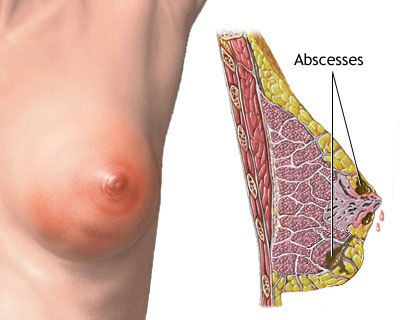Mastitis
Contents
When to Contact a Medical Professional
General Information
A breast infection is an infection in the tissue of the breast.

Most breast infections occur in breastfeeding women when bacteria enters the breast through cracks in the nipple. In severe infections, abscesses may occur. Antibiotics may be indicated for treatment.
Breast infections are usually caused by a common bacteria (Staphylococcus aureus) found on normal skin. The bacteria enter through a break or crack in the skin, usually on the nipple.
The infection takes place in the fatty tissue of the breast and causes swelling. This swelling pushes on the milk ducts. The result is pain and lumps in the infected breast.
Breast infections usually occur in women who are breastfeeding. Breast infections that are not related to breastfeeding might be a rare form of breast cancer.
Symptoms
- Breast enlargement on one side only
- Breast lump
- Breast pain
- Fever and flu-like symptoms including nausea and vomiting
- Itching
- Nipple discharge (may contain pus)
- Nipple sensation changes
- Swelling, tenderness, redness, and warmth in breast tissue
- Tender or enlarged lymph nodes in armpit on the same side
Exams and Tests
Breastfeeding women are usually not tested. However, an exam is often helpful to confirm the diagnosis and rule out complications such as an abscess.
Sometimes for infections that keep returning, milk from the nipple will be cultured. In women who are not breastfeeding, testing may include mammography or breast biopsy.
Treatment
Self-care may include applying moist heat to the infected breast tissue for 15 to 20 minutes four times a day.
Antibiotic medications are usually very effective in treating a breast infection. You are encouraged to continue to breastfeed or to pump to relieve breast engorgement from milk production while receiving treatment.
Outlook (Prognosis)
The condition usually clears quickly with antibiotic therapy.
Possible Complications
In severe infections, an abscess may develop. Abscesses need to be drained, either as an office procedure or with surgery. Women with abscesses may be told to temporarily stop breastfeeding.
When to Contact a Medical Professional
Call your health care provider if:
- Any portion of the breast tissue becomes reddened, tender, swollen, or hot
- You are breastfeeding and develop a high fever
- The lymph nodes in the armpit become tender or swollen
Prevention
The following may help reduce the risk of breast infections:
- Careful nipple care to prevent irritation and cracking
- Feeding often and pumping milk to prevent engorgement of the breast
- Proper breastfeeding technique with good latching by the baby
- Weaning slowly, over several weeks, rather than abruptly stopping breastfeeding
Alternative Names
Infection - breast tissue; Breast abscess

